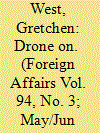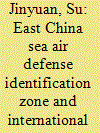| Srl | Item |
| 1 |
ID:
137562


|
|
|
|
|
| Summary/Abstract |
In the beginning, drones were almost exclusively the province of militaries. At first little more than remote-controlled model planes used in the World War I era, military drones advanced steadily over the decades, eventually becoming sophisticated tools that could surveil battlefield enemies from the sky. Today, the terms “drone” and “unmanned aircraft system” denote a vehicle that navigates through the air from point A to point B and is either remotely controlled or flies autonomously. While they vary in size and shape, such vehicles all feature a communications link, intelligent software, sensors or cameras, a power source, and a method of mobility (usually propellers).
|
|
|
|
|
|
|
|
|
|
|
|
|
|
|
|
| 2 |
ID:
139152


|
|
|
|
|
| Summary/Abstract |
Originating at the height of the Cold War, Air Defense Identification Zones (ADIZs), i.e. non-territorial airspace unilaterally designated by States for aircraft identification, had not encountered substantial protests until China's declaration of the East China Sea ADIZ in November 2013. Debates center not on the right to establish the ADIZ per se, but primarily on the purported application of identification rules to traversing aircraft, its overlap with pre-existing ADIZs claimed by other States, and the coverage of contested islands and rocks. This article argues that the identification of traversing civil aircraft does not jeopardize the paramount safety of international civil aviation, imposes only slight burden upon civil aircraft, and has garnered wide compliance. The identification of traversing military aircraft is a legitimate measure for coastal States to safeguard their security interest, and is constantly conducted by many States on a de facto basis. The overlap with ADIZs of other States and coverage of contested islands and rocks do not contradict international law and are legitimate measures for the maintenance of maritime and territorial interests. It is further suggested that all relevant States should negotiate mutually acceptable arrangements to avoid miscalculation and escalation, and to minimize confusions and inconveniences caused to third-party States.
|
|
|
|
|
|
|
|
|
|
|
|
|
|
|
|